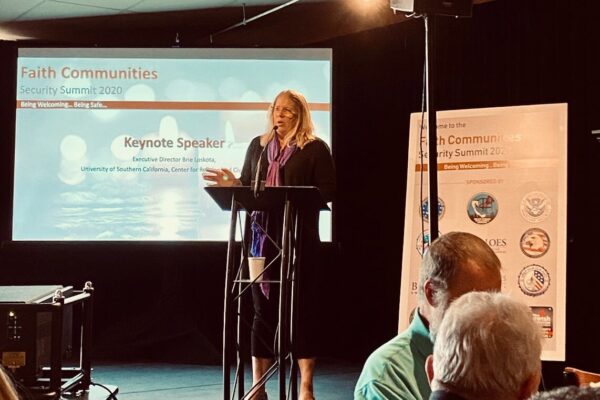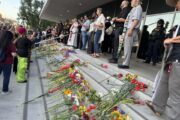Brie Loskota was the keynote speaker at the Faith Communities Security Summit, hosted by Biola University on March 3, 2020. Loskota is a board member of the LA Emergency Preparedness Foundation, one of the co-sponsors of the event. Below is the text of her speech.
When we think of congregational security, it is hard to not be flooded with images of mass shootings across the globe and in our own backyard, where those who gathered together to pray, to sing, to learn, to reflect were murdered in their most sacred and holy of places. It is not only in congregations but also in so many other locations where people have become shaken by a persistent feeling of being unsafe—being one loaded semi-automatic gun away from the next fleeting headline about a mass shooting.
As much as these incidents are horrific—and they are—they also have become blurred together. Whether you first remember a mass shooting as Charleston, or Sandy Hook, or Columbine, or in Austin, Texas, the number and frequency has made it hard to keep the subsequent ones straight.
An LA poet wrote this short poem last year after 20 people were murdered in a Wal-Mart. It’s called El Paso, by Rick Lupert.
It simply and powerfully evokes the overwhelmingness of all of these events.
I ran out of room
on the paper where I
keep track of where
these things happen
long ago.
It is easy to go numb, to go reactionary; to feel both unsafe and unprepared; and to grab for anything that feels like a lifeline, that makes you feel powerful, or in control.
Many congregations have contemplated arming themselves, picking up the line—the best way to stop a bad guy with a gun is a good guy with one.
I want to tell you about a shooting that may cause you to rethink that reaction. I’m not going to get into the 2nd amendment/gun control debate. I am going to ask you to think about the responses of congregations to crisis and ways to effectively take action to keep your folks safe.
It was a summer day on August 24, 2012 in Manhattan—the kind of day where the heat and humidity combine to zap all the energy out of a person, where the high 80s feels like nearly 100. As the business day was beginning to pick up steam, a disgruntled recently laid-off worker took a semi-automatic hand gun and shot his former co-worker in the head. He then fled the scene, walking toward the Empire State building. He pointed his weapon at police and bullets rained down. In the end, 10 more people were shot.
Why is this shooting notable?
Because of the eleven people who were shot that day, ten were shot by police. The perpetrator was killed, and nine others were injured—though none fatally—by the New York Police Department officers who responded.
The NYPD is a nearly 200-year-old institution, the largest law enforcement agency in the US, and our most recognizable police force. And yet, when faced with one active shooter, the country’s largest and arguably best trained police force were responsible for injuring nine others.
So perhaps the good guy with a gun might actually not be the solution when the good guy with a gun risks shooting someone other than the bad guy. In fact, the training required to be truly effective against an active shooter can allude even police, let alone civilians.
I was invited to join USC’s Homeland Security Center of Excellence’s counter terrorism professional course. As an outsider, I sat through fantastic and insightful learning opportunities with people who work on these issues. In one briefing, we talked about the shooting at LAX’s terminal 3 where a shooter with a semi-automatic rifle targeted TSA agents, killing one agent and wounding two, and then wounded another person as well. The shooter was wounded and taken into custody by LAX police officers.
As the shooting unfolded, plain clothes officers took their weapons out and heroically ran across LAX to respond. In doing so, they may have looked like other active shooters to the passengers at LAX. Reports came in from across the airport of multiple potential gunmen. So perhaps the good guy with the gun is hard to identify and distinguish from the bad guy with a gun.
In fact, the question of who is a good guy with a gun and who is a bad guy with a gun has led to lawful gun owners being killed by police, and the chances of that occurring are increased for populations that have endured other forms of discrimination, particularly men who are black, like Philando Castile who was pulled over at a traffic stop. He informed a police officer that he was a licensed concealed carry gun owner, but the police officer unloaded seven bullets and Castile was killed inside his car in front of his girlfriend and her preschool-aged child.
So being good guy with a gun is no guarantee of safety, and in reality for some, it puts them in more danger.
Having multiple false reports of shooters has a cascading effect which is also a big problem—it has the potential to delay the response of life-saving medical support by paramedics, because they traditionally do not go respond to places where active shooting is in progress or where the status of the shooter or shooters is unknown. Training to provide medical care under duress is different than training to deal with the aftermath, and it is not uniformly done by departments across all cities.
So, the good guy with the gun being mistaken for a bad guy with a gun could cost the lives of the injured as they bleed out while waiting for the confusion to be cleared up and the safety of the situation assessed.
The National Disaster Interfaith Network recommends the following:
All best practices, by law-enforcement and congregation security experts, instruct that the primary strategy for preventing house of worship violence is external deterrents—visible security measures and the presence of vigilant personnel. This requires trained individuals who assess and deter potential threats before they every get through the front door.
Once an intruder is inside a house of worship, the risk of getting killed or injured by the intruder, friendly fire, or injured in the chaos, is far greater than the average armed parishioner shooting the attacker first.
The emphasis of active shooter preparedness must be on preventing entry over shooting an armed intruder after they enter and reveal themselves.
This to me is where it gets really interesting. How do you prevent entry?
It turns out that, like with much of crisis and disaster response, as my colleague and noted disaster preparedness guru Ana-Marie Jones likes to say, “You are more prepared than you think.”
Congregational greeters—the ones who stand outside and welcome folks home to their scared places, the ones with a smile and a handshake or hug, the ones who know what’s going on and remember everyone—are your best security. There is no metal detector better than a deacon or elder or volunteer or sisterhood member. And that is what is so remarkable—what you do to make people feel welcomed and at home is one of your best tools for security. They can be trained, not to shoot people but to spot behavior that is out of place and to intervene when necessary.
I have worked for the last decade on understanding and building the resilience of faith communities mostly related to large-scale natural disasters like tornados, hurricanes, earthquakes, and spent the entirety of my twenty-year career working to helping support their response to social problems and disasters like inequality and injustice. The ability to survive and the ability to not let a disaster or crisis permanently derail you is connected to what you already do on a day-to-day basis.
In times of disaster, soup kitchen become sites for mass canteening where instead of feeding dozens, you stretch to feed hundreds or even thousands.
Clothing or food pantries that distribute food become sites where you distribute necessary supplies like medicine.
Prayer chains become information networks to share awareness of threats, public health emergencies, and where to get help or how to stay safe.
Parish/congregational nurses can help with medical issues, which are more likely to be a heart attack in the sanctuary or a peanut allergy anaphylaxis in the children’s program than a mass shooter.
Your online ministry might be the thing that keeps your congregation spiritually nourished and vital if it is unable to meet in person due to something like the corona virus (though the issues related to sabbath observance may limit this option for some congregations). If you do not yet have this ministry, now is a good time to start.
All of these items are things that congregations do on a regular basis, and all of those practices are the habits that are actually the foundation of your preparedness activities, that enable your response and that make your resilience more likely.
So, in order to convert this everyday capacity into crisis or disaster capacity, you need to shift a bit of the way that you think. You need to think not just about how to run an effective program, but also about what are the skills, habits, personnel and operational considerations that your organization and your people are amassing along the way. Like many challenges for congregations you need to think in pastoral or humanitarian terms—about the immediate issues of how to create a program that meets the daily needs of your congregation and community—and you need to be a strategic thinker—considering how to institutionalize, grow and support those skills and programs as you are called into action in ways that stretch your capacities, your supply chains and relationships.
As much as moving from a soup kitchen to a mass feeding program, or converting a prayer chain into a critical information pipeline is a natural evolution, it is not an inevitable one. It requires this dual level of thinking and planning, both pastoral and strategic. It requires assessing your congregation, forming internal teams, making plans and incorporating those plans into your everyday activities.
Starting every event with a reminder to find your two nearest exits and tasking three people to be responsible for calling 911 rather than the whole congregation doing so and no one being able to get through, would go a long way to enhancing congregational safety. Further, asking ushers to know who is medically trained to provide first aid or medical care, and tasking ushers or greeters with the responsibility for meeting any first responders and briefing them before they enter a congregation, takes this all to the next level. These are tasks you can do today and that may serve you tomorrow.
Knowing who is in your congregation is the critical factor for your community’s resilience. It is also the way to be aware when people are showing signs that might lead to violence. It is a rare mass shooting event where there are no signs that things are going awry in someone’s life. The common thread that unites the overwhelming majority of mass violence is domestic violence. For children and young people, the connection often manifests with abusing animals.
Sometimes the shooter in a congregational scenario is someone attacking his victim and the congregation itself becomes the target, as was the case in Sutherland Spring, Texas, where the shooter was actually prohibited from purchasing the gun he had because of a domestic violence conviction. He murdered 26 people.
And sometimes the ideological/political violence shooter has themselves practiced their violence at home before taking it to a broader target of a religious or racial group they are targeting. In more than half of mass shootings, 54 percent, the perpetrator also shot an intimate partner or relative first. This is true across the spectrum of targets and beliefs. According to a Washington post article:
Before … attacked a Planned Parenthood clinic in Colorado, two of his three ex-wives accused him of physical abuse. Before … shot up a congressional baseball practice, he was charged with domestic battery. Before [the bombing of] the Boston Marathon, [the perpetrator] faced domestic violence allegations, as well. The mother of a Nazi sympathizer called 911, afraid of her violent son, years before he allegedly killed a woman by driving his car into a Charlottesville rally… Mass violence claims all lives. Domestic violence does, too.
Congregations that acknowledge the realities of domestic violence and other forms of trauma especially that impact young people at formative stages, and then take steps to help victims and survivors, while working on accountability for perpetrators, go a long way to ensuring the overall health and wholeness of the congregants. Yet too many congregations ignore domestic violence or worse, counsel victims to forgive rather than to seek safety and healing, often driving the problem to greater invisibility.
In fact, your congregation’s overall health can be measured not by the absence of these human problems of abuse or addiction but by the response to them and the healing that it facilitates. Being a refuge of healing for those in pain is what congregations at their core do reflexively. And relationships within your congregations—between leaders and congregants, and amongst congregants themselves, and also with others in the community—are your real lifelines
And yet congregational leaders neglect the soul-feeding power of relationships too often.
Congregational leaders are already stretched and stressed. Many are overwhelmed by the day to day life of leading a congregation. When, you bury people who you just baptized or bar/bat mitzvahed or confirmed, it is easy for congregational leaders to put up walls around themselves to protect them from the emotion toil of the work they do. And this work of pastoral care especially in these times seems unending. It creates isolation for congregational leaders, which compounds rather than protects from trauma and despair. One of the great black church leaders of Los Angeles, Rev. Dr. Cecil Murray, would say that he only had one friend in ministry. A remarkably lonely assessment of what it’s like to lead a congregation of 17,000 members.
Burnout is real and caring for yourself is critical. When congregational leaders are near burnout, what they need is connection. No one can do this work alone. In fact the Book of Job reflects on the human impulse to be together in times of hardship. In the Book of Job 2:11, it recalls when Job’s three friends, Eliphaz the Temanite, Bildad the Shuhite, and Zophar the Naamathite, heard about all the troubles that had come upon him, they set out from their homes and met together by agreement to go and sympathize with him and comfort him.
Yet we are out of practice of the habits of these friendships, especially if we are in leadership. Because people always want things from us and need things from us and demand things from us.
But your ability to respond to a situation is enhanced by the relationships you form before a crisis or disaster. This room represents a vast array of human capital. But how many of us have made meaningful connections today? How many of us feel overwhelmed by these types of rooms and gatherings? How many of us leave having learned something but without any new or deeper relationships with another human in this room?
I’m going to ask you to engage in a short activity at your table. I’d like you to turn to the person next to you and ask them to share with you the story of their name. It can be their first name, middle name, last name, a nickname. Anything. And just have a conversation with them for a few minutes. Then I’ll let you know when a few moments have passed and I’ll ask you two to switch roles.
Why do this in a conference about security? Because first, we need to remember that people matter. Not in the abstract, but the person next to you matters. Second, we need to remember that connection matters. We cannot be fully human when we are isolated and alone. We are relational being and being in relationship feeds us. And finally, because remembering that people matter and that connection matters will hopefully motivate you to think about what more you can do to take whatever it is that you learned today and implement it—whether that is about training your personnel to assess behavior before a person enters, or to understand and support those who have been victimized by domestic violence, or to do an emergency briefing before a gathering, or to think about your everyday programs and start to plan for their use in crisis and disasters, or simply to form a team of relationships that nurture your own personal resilience so you can be prepared and resourced to do any of this work. Whatever small or large steps you feel called to do, take them and implement them in your congregations so that you can help all people flourish, including yourself.
Brie Loskota is the former executive director (2016-2021) of the USC Center for Religion and Civil Culture.







